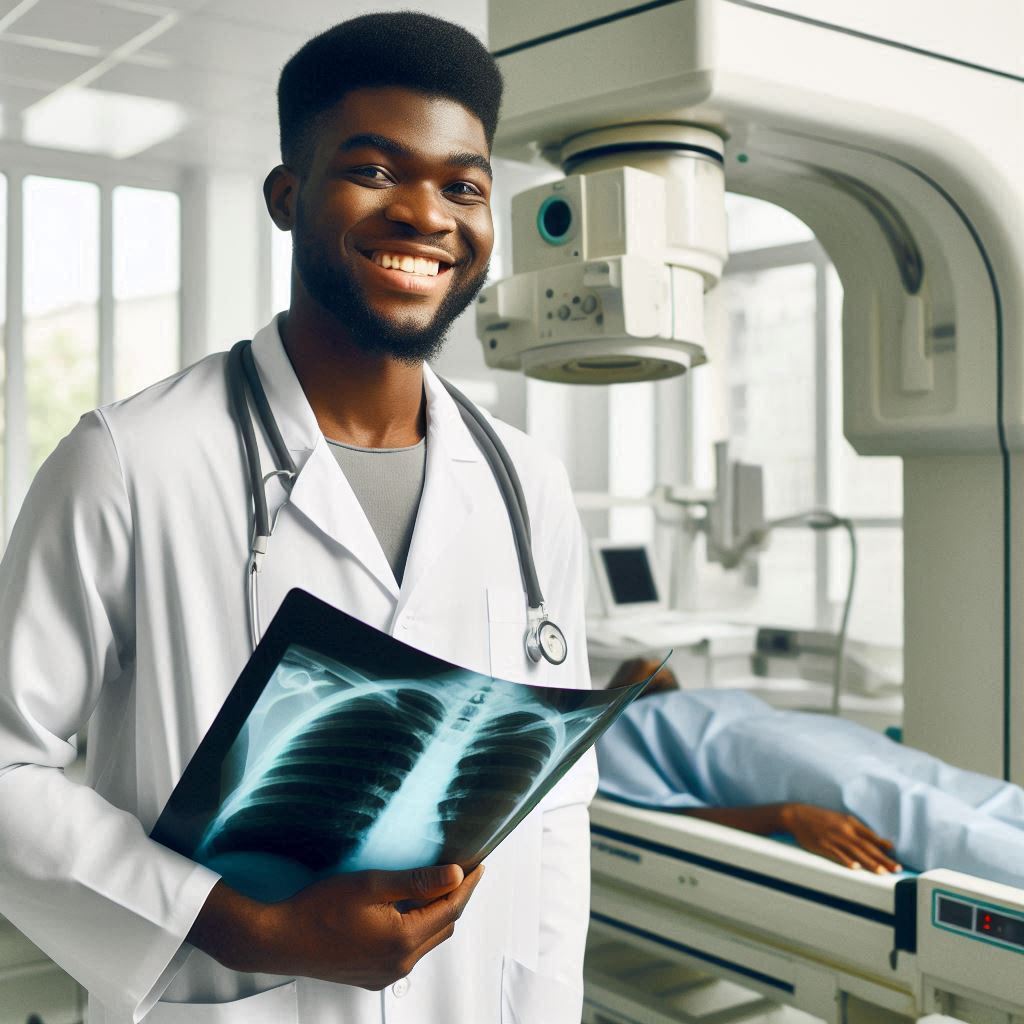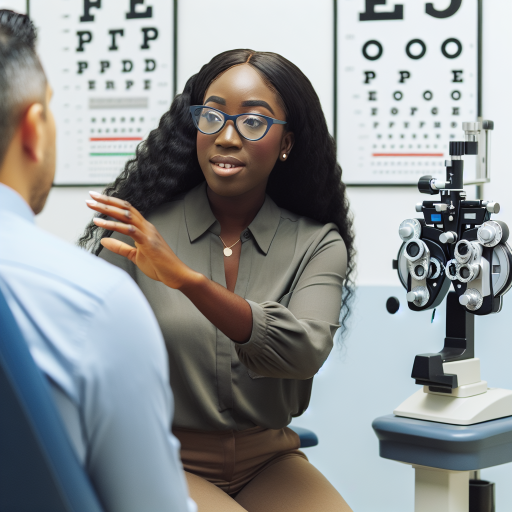Introduction
Becoming a radiographer involves playing a vital role in healthcare by using imaging technology to assist in diagnosing diseases.
These professionals operate equipment like X-rays, CT scans, and MRIs.
Their expertise directly impacts patient care and outcomes.
Radiography is essential in diagnostics.
It provides crucial images that help physicians make informed decisions.
Early detection of conditions often saves lives.
Radiographers ensure the images are clear and precise for proper analysis.
They also maintain patient safety during imaging procedures.
This blog post aims to guide aspiring radiographers in Nigeria.
We will explore the education, skills, and certifications required.
Additionally, we will discuss the job opportunities in the field.
Aspiring radiographers will benefit from understanding the career path ahead.
Becoming a radiographer requires a solid educational foundation.
Students typically pursue a degree or diploma in radiography.
Many institutions in Nigeria offer accredited programs.
Aspiring students should research schools with strong reputations and facilities.
In addition to formal education, practical experience is critical.
Students often undergo internships in hospitals or clinics.
This hands-on training helps bridge the gap between theory and practice.
It builds confidence and enhances technical skills in real-world environments.
After completing their education, candidates must obtain certification.
The Health Records Officers’ Registration Board of Nigeria oversees this process.
Successful candidates receive a license to practice as radiographers.
This certification is crucial for employment in healthcare facilities.
Radiographers must possess certain skills to succeed.
Strong communication skills facilitate clear interactions with patients and healthcare teams.
Analytical skills aid in interpreting imaging results effectively.
Attention to detail ensures accurate imaging and patient safety.
Basically, radiographers are indispensable in healthcare.
They provide essential diagnostic services that enhance patient care.
By following the outlined steps, aspiring radiographers can successfully embark on this rewarding career.
What is Radiography?
Radiography is a vital branch of medical imaging.
It involves using radiation to capture diagnostic images of the body.
These images help healthcare professionals diagnose and treat various medical conditions.
Radiography encompasses multiple modalities, each with its own purpose and application.
Definition and Scope of Radiography
Radiography primarily focuses on creating images of the internal structures of the body.
Radiographers utilize different types of equipment to capture these images.
The scope of radiography extends beyond just taking X-rays.
It involves working with various imaging technologies that enhance patient care and treatment options.
The profession of radiography is critical in the healthcare system.
Radiographers must have proper training and education.
They work closely with radiologists, physicians, and other healthcare professionals.
Together, they ensure accurate diagnosis and effective treatment planning.
Different Modalities in Radiography
Radiography includes several imaging modalities, each serving unique purposes.
- X-rays: These are the most common form of imaging.
X-rays help in visualizing bones and organs.
They provide a quick way to assess injuries or abnormalities. - Computed Tomography (CT) Scans: CT scans produce detailed cross-sectional images.
They offer a more comprehensive view than standard X-rays.
This modality is essential for diagnosing conditions in complex areas, like the brain or abdomen. - Magnetic Resonance Imaging (MRI): MRI uses strong magnetic fields and radio waves.
It provides high-resolution images of soft tissues.
Doctors often use it to evaluate brain, spinal cord, and joint issues. - Ultrasound: This modality employs sound waves to produce images.
Ultrasound is safe and commonly used for obstetric scanning.
It helps visualize the developing fetus in the womb. - Nuclear Medicine: This imaging technique uses small amounts of radioactive materials.
It allows for both functional and structural imaging.
It is especially useful for diagnosing certain cancers and assessing organ function. - Fluoroscopy: This technique provides real-time imaging.
It is often used in examining the digestive system.
Doctors use it to guide procedures such as catheter placements.
The Significance of Radiographic Imaging in Medical Diagnosis
Radiographic imaging plays a crucial role in modern medicine.
It supports healthcare professionals in making informed decisions.
The benefits of radiographic imaging include:
- Early Detection: Imaging allows for the early identification of diseases.
Conditions such as cancer, fractures, and infections can be diagnosed promptly. - Accurate Diagnosis: Radiographs provide detailed information.
They enable the healthcare team to make accurate diagnoses and craft effective treatment plans. - Guiding Treatment: Imaging helps guide surgeries and other interventions.
For example, it can assist in localizing tumors for removal. - Monitoring Progress: Radiographic imaging allows for tracking treatment effectiveness.
It enables physicians to adjust treatment strategies based on patient response. - Patient Safety: Advanced imaging techniques minimize the need for invasive procedures.
This reduces risks associated with surgery and enhances patient safety. - Research and Development: Radiographic imaging continues to advance.
Researchers are developing new techniques and technologies to improve diagnostics further.
Overall, radiography significantly impacts patient care in Nigeria.
The profession contributes to effective healthcare delivery.
Radiographers play a vital role within multidisciplinary teams.
They ensure patients receive comprehensive and efficient care.
As healthcare demands rise, the need for skilled radiographers increases.
Many educational institutions in Nigeria offer programs to train aspiring radiographers.
These programs equip students with essential knowledge and practical skills.
Understanding the modalities and significance of radiography is paramount for aspiring professionals.
Knowledge of how each modality functions allows radiographers to specialize.
This specialization enriches their skills and enhances their career opportunities.
In fact, radiography is an indispensable aspect of healthcare.
Its diverse modalities and applications contribute to advancing medical diagnosis and treatment.
As technology evolves, radiography will continue to expand its scope.
Ultimately, it will enhance patient care and improve health outcomes across Nigeria.
Educational Pathway to Becoming a Radiographer
Becoming a radiographer in Nigeria requires a structured educational pathway and practical training.
Aspiring radiographers must navigate through various programs and degrees.
This journey equips them with the necessary skills to perform diagnostic imaging procedures.
Clinical Radiography Programs Available in Nigeria
Nigeria offers several clinical radiography programs.
Different institutions provide these programs, each with its unique curriculum.
Here are some of the key programs available:
- National Diploma (ND) in Radiography: This is a two-year program designed for students looking to enter the field quickly.
- Bachelor of Science (B.Sc.) in Radiography: This is a four-year degree program that provides in-depth knowledge of radiography.
- Postgraduate Programs: These include Master’s degrees and specialized training programs for those who want advanced knowledge.
Overview of Relevant Degree Programs
Students can choose from various degree programs, each fulfilling different educational needs.
National Diploma (ND) in Radiography
The ND program is typically offered by polytechnics across Nigeria.
It requires a minimum of five credits in relevant subjects.
This includes Biology, Chemistry, Physics, Mathematics, and English.
During this program, students gain theoretical knowledge and practical skills.
Core subjects usually include:
- Radiographic Techniques
- Radiographic Physics
- Pathophysiology
- Radiation Protection
Students also complete clinical training in hospitals, gaining hands-on experience.
The ND program typically lasts for two years.
Bachelor of Science (B.Sc.) in Radiography
The B.Sc. program offers a more comprehensive education.
It usually includes both classroom study and clinical practice.
It lasts for four years and covers advanced topics such as:
- Medical Imaging
- MRI and CT Imaging
- Nuclear Medicine
- Sonography
Entry into a good B.Sc. program requires good grades in relevant subjects, similar to the ND program.
Students often engage in research projects, enhancing their understanding of radiography.
Postgraduate Programs
After completing a B.Sc. degree, graduates can pursue postgraduate studies.
Master’s programs focus on advanced radiographic techniques and research.
Specializations may include:
- Radiation Therapy
- Pediatric Radiography
- Interventional Radiology
Postgraduate studies enable radiographers to reach higher professional levels.
They can also contribute to teaching and research in radiography.
Duration of Study and Curriculum Highlights
The duration of study depends on the chosen program.
Here’s a breakdown:
- ND in Radiography: 2 years – students learn basic radiographic techniques and procedures.
- B.Sc. in Radiography: 4 years – students receive comprehensive training, including advanced imaging techniques.
- Postgraduate Programs: 1-2 years – focused training in specialized areas of radiography.
Curriculum Highlights
Each program has a mix of theoretical and practical training.
Here are some highlights of the curriculum:
- Fundamentals of Radiography: Introduces students to radiographic principles and practices.
- Radiographic Imaging: Covers various imaging modalities and techniques.
- Radiation Biology and Safety: Focuses on the effects of radiation and safety protocols.
- Diagnostic Pathology: Teaches students how to interpret imaging results effectively.
Most programs also involve extensive clinical rotations.
These rotations allow students to apply their knowledge and gain real-world experience.
Becoming a radiographer in Nigeria involves a structured educational pathway.
Students must carefully select their programs based on career goals.
The ND and B.Sc. degrees lay the foundation for a successful career in radiography.
Postgraduate studies further enhance their expertise and opportunities in the field.
Graduates can expect diverse career paths in hospitals, clinics, and research facilities.
With the right education and training, aspiring radiographers can contribute significantly to healthcare.
Read: Must-Know Healthcare Professions Thriving in Nigeria
Accreditation and Certification Requirements
Becoming a radiographer in Nigeria requires a thorough understanding of accreditation and certification requirements.
These stages are crucial to your career trajectory, ensuring that you meet the necessary standards for practice.
Importance of Accreditation from Recognized Institutions
Accreditation plays a significant role in radiography education.
It ensures that institutions meet strict standards and provide quality training.
Here are some key points on the importance of accreditation:
- Quality Assurance: Accreditation ensures that educational programs maintain high standards.
- Curriculum Relevance: Accredited programs frequently update curricula to reflect current practices.
- Employment Opportunities: Employers prefer graduates from accredited institutions, recognizing their competence.
- Licensure Eligibility: Many regulatory bodies require accreditation for eligibility to sit for licensure exams.
- Student Support: Accredited institutions often provide better resources and support services.
In Nigeria, it is crucial to select programs recognized by the Radiographers Registration Board of Nigeria (RRBN).
The RRBN ensures that training meets national professional standards.
Thus, attending an accredited program sets a strong foundation for your radiography career.
Overview of the Certification Process
Certification is a vital step in becoming a licensed radiographer.
This process ensures that radiographers possess the necessary skills and knowledge.
The main body governing certification in Nigeria is the Radiographers Registration Board of Nigeria (RRBN).
Here is an overview of the certification process:
- Educational Qualification: Complete an accredited radiography program with a recognized qualification.
- Practical Training: Undergo supervised clinical training to gain hands-on experience.
- Application for Examination: Submit an application to the RRBN to sit for the licensure examination.
- Examination: Pass the qualifying examination administered by the RRBN.
- Issuance of License: Obtain your professional license upon successful completion of all requirements.
Passing the RRBN examination is crucial for your career.
This examination tests your theoretical knowledge and practical skills.
Therefore, prepare thoroughly and seek assistance from mentors or peers when needed.
Continuous Professional Development and Recertification
The field of radiography continually evolves with technology and techniques.
Continuous professional development (CPD) is essential for staying updated.
Here’s what to know about CPD and recertification:
- Mandatory CPD: Participating in ongoing education is often required to maintain your license.
- Workshops and Seminars: Attend various workshops and seminars to expand your skills and knowledge.
- Online Courses: Utilize online resources and courses to learn at your pace.
- Peer Review: Engage in peer reviews and discussions to enhance your understanding of contemporary issues.
- Professional Organizations: Join professional bodies for networking and updated information on advancements.
Regularly updating your skills strengthens your career potential.
Most employers value and expect continuous learning.
Staying relevant in the field ensures you provide the best care to patients.
Recertification is another crucial aspect of maintaining your licensure.
It typically involves submitting proof of completed CPD activities within a designated period.
Many bodies require this to ensure that radiographers remain competent.
Understanding accreditation and certification requirements is key to a successful career in radiography.
Select an accredited institution to gain valuable education.
Follow the certification process diligently and prepare well for the RRBN examination.
Engaging in continuous professional development enhances your skills and expertise.
Be proactive in recertification requirements to maintain your license.
Being a competent and informed radiographer allows you to contribute significantly to patient care and the healthcare system.
Read: Comparison: Physician Assistants vs Doctors in Nigeria
Skills and Competencies Needed
Becoming a successful radiographer in Nigeria requires a diverse set of skills and competencies.
These abilities ensure efficiency and effectiveness in the ever-evolving health sector.
Below are key skills and competencies essential for radiographers, along with insights about continuous training and soft skills.
Key Skills Required for Successful Radiographers
Technical Skills
Radiographers utilize various technologies and equipment to perform imaging procedures.
Therefore, they must master the operation of radiographic machines, including:
- X-ray machines
- CT scanners
- MRIs
- Ultrasound equipment
- Fluoroscopy machines
They must also understand radiation safety protocols and maintain compliance with relevant regulations.
Familiarity with digital imaging software enhances their ability to produce and analyze high-quality images.
Diagnostic imaging requires not just equipment knowledge, but also an understanding of human anatomy.
Interpersonal Skills
Radiographers interact closely with patients, so strong interpersonal skills are paramount.
They need to exhibit empathy, compassion, and patience.
Successful communication helps allay patients’ fears about procedures.
Additionally, they collaborate with a team of healthcare professionals.
Good teamwork improves the overall patient care process.
Attention to Detail
Radiographers must possess acute attention to detail.
They analyze images and identify any abnormalities.
Missing a key detail can lead to misdiagnosis, which impacts patient care.
Thus, they must accurately assess the images and ensure that all necessary views are taken.
Precise patient positioning can also affect image quality.
Importance of Soft Skills in Patient Interaction
The importance of soft skills cannot be overstated.
Radiographers often work with patients who are anxious or uncomfortable.
Soft skills help mitigate these feelings through effective patient interaction.
- Empathy: Understanding a patient’s feelings fosters trust.
- Active Listening: Listening attentively to patients’ concerns ensures proper care.
- Clear Communication: Explaining procedures in simple terms helps reduce fear.
- Problem-Solving: Quick thinking is essential in emergency situations.
- Conflict Resolution: Handling misunderstandings calmly is crucial in a healthcare setting.
Radiographers often perform critical functions that directly affect patient outcomes.
Thus, their ability to connect with patients enhances the overall experience.
Additionally, collaboration with medical staff improves the quality of care provided.
Ongoing Training and Skill Enhancement Opportunities
The healthcare field is constantly evolving, which necessitates ongoing education for radiographers.
New technologies, procedures, and regulations emerge regularly.
Radiographers must stay updated to provide the best care.
Professional development opportunities include:
- Workshops: These provide hands-on experience with new technologies.
- Conferences: Networking with other professionals helps share knowledge and practices.
- Online Courses: Flexible and self-paced learning is accessible on various platforms.
- Certification Programs: Specialized credentials enhance credibility and expertise.
- Continuing Education Units (CEUs): Many organizations require ongoing training for certification renewal.
Radiographers can also join professional bodies that offer resources for skill enhancement.
Organizations such as the Radiographers Registration Board of Nigeria (RRBN) aim to maintain high standards in the profession.
Additionally, mentorship programs can provide guidance from experienced radiographers.
Investing time and effort in personal development not only enhances competencies but also builds a successful career.
It boosts confidence in handling various patient cases and the management of new equipment.
In short, a radiographer’s role is multifaceted, requiring a blend of technical expertise, interpersonal skills, and meticulous attention to detail.
The relevance of soft skills in patient interaction and ongoing learning cannot be ignored.
Aspiring radiographers should focus on developing these competencies to ensure success in their careers.
Commitment to professional growth and understanding the importance of patient interaction ultimately leads to improved healthcare outcomes in Nigeria.
Read: Understanding the Ethics for Physician Assistants in Nigeria

Career Opportunities for Radiographers in Nigeria
Radiography is a dynamic and rewarding career, offering numerous opportunities in Nigeria.
As healthcare expands, radiographers become increasingly essential.
They play a crucial role in diagnosing and treating patients.
The variety of sectors where radiographers work makes this profession appealing.
Various Sectors of Employment
Radiographers can find employment in a multitude of settings.
Here are the primary sectors that offer promising job prospects:
- Hospitals: Most radiographers work in hospitals, both public and private.
They perform imaging tests, support patient care, and collaborate with other health professionals. - Clinics: Outpatient clinics provide additional job opportunities.
Radiographers in clinics may focus on specific imaging services, such as X-rays and ultrasounds. - Research Institutes: Research institutes often seek radiographers for projects.
In these settings, radiographers engage in innovative medical research and development. - Academia: Teaching positions at universities and colleges are available for experienced radiographers.
They educate future professionals, contributing to the field’s growth.
Potential for Specialization
One of the exciting aspects of a radiography career is the scope for specialization.
Radiographers can hone their skills in specific areas, enhancing their expertise and employability.
Some common specializations include:
- Mammography: This specialization focuses on breast imaging.
Mammographers play a vital role in early breast cancer detection. - Interventional Radiography: Radiographers in this field assist with minimally invasive procedures.
They support doctors using imaging guidance to execute treatments. - CT and MRI Imaging: Advanced training in computed tomography and magnetic resonance imaging is highly sought after.
Specialists in these areas conduct detailed scans for diagnosis. - Pediatric Radiography: Working specifically with children requires unique skills.
Pediatric radiographers adapt imaging techniques to suit younger patients. - Radiation Therapy: This specialization involves treating cancer patients.
Radiographers collaborate closely with oncologists to ensure accurate treatment delivery.
Career Advancement Options and Roles
Radiography offers numerous career advancement opportunities.
With experience and additional training, radiographers can move into higher roles.
Some of these include:
- Lead Radiographer: This position involves supervising a team of radiographers.
The lead radiographer ensures the department runs smoothly and efficiently. - Chief Radiographer: As chief, professionals oversee multiple departments or facilities.
They manage staff, budgets, and operational standards. - Radiological Technologist: This role focuses on advanced technology and imaging procedures.
Technologists often specialize in specific imaging modalities. - Clinical Educator: Experienced radiographers may become educators, training new radiography students.
This role combines clinical practice with teaching responsibilities. - Research Scientist: Radiographers can contribute to innovations in imaging through research.
They may develop new techniques or improve existing methods.
Networking and Professional Associations
Networking is essential for career growth.
Joining professional associations can open doors to new opportunities.
In Nigeria, organizations such as:
- Nigerian Society of Radiographers (NSR): This organization promotes the interests of radiographers.
Membership provides access to resources and professional development. - Radiologic Society of Nigeria (RSN): The RSN focuses on advancing radiology in Nigeria.
It also facilitates networking and collaboration among professionals.
Continuing Education and Training
The field of radiography is constantly evolving.
Therefore, continuous education is vital.
Radiographers should pursue training sessions, workshops, and online courses.
Staying updated on technological advancements and new techniques enhances their skills.
Job Market Outlook
The job market for radiographers in Nigeria is promising.
Growing healthcare needs imply increasing demand for imaging services.
As more facilities expand, radiographer positions will likely rise.
Furthermore, government and private sector investments in healthcare improve job stability.
In essence, radiography offers a breadth of career opportunities in Nigeria.
With diverse sectors of employment, potential for specialization, and various advancement options, aspiring radiographers can build successful careers.
Continuous learning and networking enhance professional growth, ensuring a meaningful impact on patient care.
Embracing this career path can fulfill both personal ambitions and contribute to the healthcare landscape in Nigeria.
Read: Work-life Balance for Physician Assistants in Nigeria
Challenges Faced by Radiographers in Nigeria
Radiography plays a crucial role in Nigeria’s healthcare system.
However, radiographers face numerous challenges that can hinder their effectiveness.
Understanding these challenges is essential for aspiring radiographers and healthcare policymakers.
Common Challenges in the Radiography Profession
Radiographers in Nigeria encounter various obstacles that affect their day-to-day operations.
Here are some of the most prevalent issues:
- Equipment Limitations: Many healthcare facilities lack modern imaging equipment.
- Maintenance Issues: Existing machines often suffer from poor maintenance and frequent breakdowns.
- High Workload: Radiographers frequently face overwhelming patient loads, leading to burnout.
- Inadequate Staffing: A shortage of trained professionals exacerbates workflow issues in many hospitals.
- Limited Access to Training: Ongoing education opportunities are often scarce, impacting skills enhancement.
- Outdated Techniques: Some radiographers still use traditional radiographic techniques due to resource constraints.
- Healthcare Policies: Inconsistent healthcare policies can create unnecessary bureaucratic hurdles.
The Impact of Infrastructure and Healthcare Policies
The state of healthcare infrastructure in Nigeria significantly affects radiography.
Here are key impacts:
- Poor Infrastructure: Insufficient or dilapidated healthcare facilities limit radiographic services.
- Inconsistent Power Supply: Frequent power outages disrupt imaging services and compromise patient care.
- Healthcare Funding: Inadequate government funding leads to underinvestment in essential medical equipment.
- Policy Gaps: A lack of clear policies regarding radiography practice can lead to confusion and inefficient practices.
- Regulatory Challenges: Bureaucratic red tape can slow down the acquisition of new equipment or technology.
- Public Health Initiatives: Insufficient emphasis on preventive care can increase the reliance on imaging services.
Strategies for Overcoming Challenges
Addressing the challenges faced by radiographers is essential for improving healthcare outcomes.
Here are some effective strategies:
- Advocacy for Better Funding: Radiographers must advocate for increased government spending on healthcare.
- Public-Private Partnerships: Engaging private sectors can improve funding and resource allocation.
- Regular Maintenance: Establishing a routine maintenance schedule for equipment can reduce breakdowns.
- Continued Education: Encouraging ongoing training helps radiographers stay updated with technology.
- Workload Management: Implementing better staffing strategies can help distribute patient loads effectively.
- Improving Infrastructure: Community outreach and partnerships can foster improvements in healthcare facilities.
- Policy Reform: Advocating for clear and consistent healthcare policies can streamline practices.
Furthermore, radiographers should collaborate with health authorities to develop policies that address their specific needs.
Networking with other radiography professionals can provide valuable insights and resources.
Engaging in professional organizations can amplify their collective voices in advocating for change.
Support systems play an essential role in enhancing the radiography profession.
Peer support among radiographers can foster a collaborative work environment.
Establishing mentorship programs can guide new radiographers and help them navigate challenges.
Innovation also plays a significant part in overcoming barriers.
Incorporating tele-radiology can improve access to imaging services, especially in rural areas.
Additionally, leveraging technology can enhance efficiency and accuracy in diagnostic procedures.
In general, while radiographers in Nigeria face significant challenges, solutions exist.
By advocating for better resources, engaging in continuous education, and promoting collaborative practices, radiographers can enhance their profession.
Improving the overall healthcare infrastructure will also contribute to better health outcomes across Nigeria.
Ultimately, addressing these challenges requires collective effort.
Stakeholders must work together to develop sustainable solutions.
By doing so, they can ensure that radiographers continue to play a vital role in protecting and improving public health throughout Nigeria.
Future of Radiography in Nigeria
The future of radiography in Nigeria holds great promise.
As healthcare evolves, radiography will play a critical role.
This section explores essential trends and advancements shaping the profession.
Trends and Advancements in Radiographic Technology and Practices
Radiographic technology is advancing rapidly.
New innovations significantly improve diagnostic capabilities.
Below are some key trends in radiography:
- Digital Radiography: Digital radiography enhances image quality.
It reduces radiation exposure and speeds up the imaging process. - 3D Imaging: Three-dimensional imaging provides clearer anatomical details.
This improvement aids in accurate diagnoses and treatment planning. - Artificial Intelligence: AI technologies help in image analysis.
They can automatically identify abnormalities, thereby improving efficiency. - Portable Imaging Devices: Portable imaging units offer flexibility.
They allow radiographers to perform procedures in various settings, including remote areas. - Enhanced Safety Protocols: The industry emphasizes patient safety.
Innovations in safety protocols minimize radiation risks during imaging.
These advancements represent a shift towards more efficient, accurate, and patient-centered radiographic practices.
Radiographers must stay updated on these trends for improved outcomes.
The Role of Tele-Radiology and Digital Imaging
Tele-radiology and digital imaging are transforming healthcare delivery in Nigeria.
These technologies broaden access and improve patient care.
Here’s how they impact the field:
- Remote Access to Specialists: Tele-radiology enables remote consultations.
Doctors can review images and provide expert opinions from anywhere. - Improved Workflow: Digital imaging streamlines the workflow.
Radiologists can quickly access and share images among healthcare teams. - Quick Diagnosis: Fast image transfer facilitates timely diagnoses.
Patients receive prompt treatment, which is crucial during emergencies. - Education and Training: Tele-radiology supports continuous learning.
Radiographers can attend online workshops and training sessions from leading experts. - Cost-Effective Solutions: Implementing tele-radiology reduces costs.
It minimizes the need for physical consultations and transportation.
These aspects illustrate how tele-radiology and digital imaging positively influence radiography practice in Nigeria.
The Potential for Growth and the Evolving Landscape of Healthcare in Nigeria
Nigeria’s healthcare sector is evolving rapidly, presenting significant growth opportunities for radiography.
As the population grows, the demand for healthcare services increases.
This section discusses potential growth areas in radiography:
- Healthcare Accessibility: The government is investing in healthcare infrastructure.
This investment enhances access to radiographic services in underserved areas. - Increased Health Awareness: Nigerians are becoming more health-conscious.
This shift leads to a higher demand for diagnostic imaging services. - Integration of Technology: The adoption of advanced technologies will continue to rise.
Radiographers must adapt to these technological changes. - Collaboration with Other Disciplines: Radiography will increasingly collaborate with other medical fields.
These partnerships can improve patient outcomes and interdisciplinary care. - Investment in Research and Development: There is a growing focus on research.
This investment will drive innovations in radiographic techniques and practices.
The future of radiography in Nigeria is bright and filled with opportunities.
It is crucial for radiographers to embrace changes in the healthcare landscape.
Continuous professional development will be vital for success in this evolving field.
As healthcare systems modernize, radiography will play an essential role.
Radiographers must prepare for advancements in technology and practice.
Understanding the trends, integrating tele-radiology, and addressing growth potentials are critical steps.
Those interested in becoming radiographers in Nigeria should stay informed.
They must continuously seek opportunities for growth and development.
The future hinges on their adaptability and commitment to excellence.
Conclusion
In this article, we explored the essential steps to becoming a radiographer in Nigeria.
We discussed the educational requirements, necessary skills, and professional registration processes.
These components form the foundation of a successful career in radiography.
A good understanding of anatomy and medical imaging techniques is vital for effective practice.
Radiographers play a crucial role in diagnosing and treating patients.
Their expertise contributes significantly to patient care in healthcare settings.
We also highlighted the importance of practical experience during training.
Gaining hands-on exposure in clinical environments enhances skills and confidence.
Aspiring radiographers should seek opportunities to learn from seasoned professionals.
Publish Your Professional Profile, Business or Brand
Showcase your expertise, gain trust, and boost visibility instantly on Professions.ng.
Publish NowAs you consider embarking on this rewarding path, remember that challenges may arise.
However, your dedication and perseverance will lead to a fulfilling career in radiography.
Embrace continuous learning, as medical technology constantly evolves.
Finally, we encourage all aspiring radiographers to pursue their passion.
This profession offers various career paths, including specializations in sonography and MRI.
Your contribution to healthcare can truly make a difference in patients’ lives.
We invite you to share your experiences and insights on your journey.
Engaging with others can provide support and motivation.
Together, let’s foster a community of aspiring radiographers in Nigeria.




